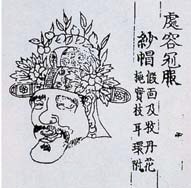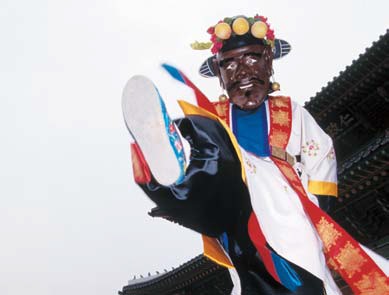View this article in another language
- 한국어
- English
- 日本語
- 中文
- العربية
- Español
- Français
- Deutsch
- Pусский
- Tiếng Việt
- Indonesian
*This is the first part in our series, “Masks & the Mask Dance” published in partnership with the National Research Institute of Cultural Heritage
Masks & the Mask Dance
Masks, the so-called, "other face of humanity," turn the human being into another character, veiling the original face. Throughout the world, masks have been created in a diverse range of forms, embodying each community's identity and traditions. In Korean, such traditional masks are called tal.
 The traditional Korean mask has been used since prehistoric times. They were typically worn during royal court ceremonies, during folk festivals and were used for entertainment across the country in times before modern media. The traditional Korean mask dance, the talchum, is a drama that developed as folk festival entertainment played in an open-air theater.
The traditional Korean mask has been used since prehistoric times. They were typically worn during royal court ceremonies, during folk festivals and were used for entertainment across the country in times before modern media. The traditional Korean mask dance, the talchum, is a drama that developed as folk festival entertainment played in an open-air theater.
Across the country, the talchum was commonly performed to sharply criticize contemporary society and create humorous satire that depicted the falsehoods and hypocrisies of the upper classes. In additional to cheerful music and energetic dancing, the traditional mask dance has now been recognized as one of the official cultural symbols of Korea.
1. What is a mask?
The word tal refers to a mask that is crafted by shaping wood or sheets of paper into a representation of a human or animal face and which is worn to cover the entire face. The word also includes a second meaning of misfortune, illness and difficulty. For example, when someone becomes sick or runs into trouble, you can use the word tal, as in the phrase, "Talinatda," meaning, "I am sick," or, "I am in trouble." The word for masks represents something that people hope is only a passing event.
Interestingly, people were reluctant to hold onto the word tal in its meaning of a mask. In the past, they believed that if they kept a mask nearby, they would be in trouble due to the bad luck attached to the mask. Therefore, they stored the masks in a village shrine or burned them immediately after the ritual for which they were created.
People regarded masks as religious objects, something that should be feared, worshiped and enshrined.
The following legend of Cheoyong has been passed down ever since the Silla Kingdom (57 B.C.-A.D. 935) and tells us more about how the ancients viewed their masks.
Cheoyong, a son of the dragon king, had such a beautiful wife that the devils wanted her for themselves. One night, after Cheoyong had been out all day, he came back home to find the spirit of smallpox in bed with his wife. Despite what he had witnessed, he did not allow any expression of rage to cross his face. Rather, he stepped back out of his house and began to sing and perform a dance.
The song went like this:
"With the bright moon in the east, after wandering around all day,
I come back and see four legs in my bed.
Two are surly mine, but whose are these other two?
They used to belong to my wife, but what can I do after being robbed?"
The spirit of smallpox was more than a little surprised to see Cheoyong singing and dancing rather than becoming furious. The spirit recognized that Cheoyong was such a magnanimous man that he could not stand against him. He kneeled down in front of Cheoyong and said, "My lord, I am deeply impressed by your virtue. Upon my oath, I will never go near any place that has a likeness of your face. Please forgive me this one time."
 Afterward, the spirit of smallpox would not pass through a door with a representation of Cheoyong hanging on it. This is when the people of Silla began to put a likeness of Cheoyong on the gate to drive away evil spirits and to invite good fortune. This legend of Cheoyong led to the creation of the Cheoyong mask, which was designed to drive away negative spirits and was revered as an object of worship.
Afterward, the spirit of smallpox would not pass through a door with a representation of Cheoyong hanging on it. This is when the people of Silla began to put a likeness of Cheoyong on the gate to drive away evil spirits and to invite good fortune. This legend of Cheoyong led to the creation of the Cheoyong mask, which was designed to drive away negative spirits and was revered as an object of worship.
In ancient times, it was believed that illness was brought by evil spirits and that they could be repelled by means of a fearsome-looking mask. Thus, masks were always used in exorcism rituals, funerals and communal rites to pay for the well-being of the village. This suggests that tal, as in, "trouble," can only be defeated by using an even more frightening tal, or, "mask."
Such exorcism functions are not unique to Korean masks. Various types of masks have long existed all over the world, originating in religious or exorcism ceremonies dating back to the earliest times.
In prehistoric times, people wore animal-inspired masks created to channel the power of a ferocious animal or to console the spirit of that animal. They also attached symbolic meanings to terrifying theomorphic masks -- masks in the shape of a god -- meant to protect against evil spirits or external enemies. It was common to believe one could become an animal or a supernatural being by wearing such a mask.
From ancient times, as in many other parts of the planet, people used masks in rituals designed to pray for a bountiful harvest, cure disease, drive away evil spirits and to serve the gods.
*This series of article has been made possible through the cooperation of the National Research Institute of Cultural Heritage. (Source: Intangible Cultural Heritage of Korea)
Masks & the Mask Dance
Masks, the so-called, "other face of humanity," turn the human being into another character, veiling the original face. Throughout the world, masks have been created in a diverse range of forms, embodying each community's identity and traditions. In Korean, such traditional masks are called tal.

Cheoyong mask from the Canon of Music (1493)
Across the country, the talchum was commonly performed to sharply criticize contemporary society and create humorous satire that depicted the falsehoods and hypocrisies of the upper classes. In additional to cheerful music and energetic dancing, the traditional mask dance has now been recognized as one of the official cultural symbols of Korea.
1. What is a mask?
The word tal refers to a mask that is crafted by shaping wood or sheets of paper into a representation of a human or animal face and which is worn to cover the entire face. The word also includes a second meaning of misfortune, illness and difficulty. For example, when someone becomes sick or runs into trouble, you can use the word tal, as in the phrase, "Talinatda," meaning, "I am sick," or, "I am in trouble." The word for masks represents something that people hope is only a passing event.
Interestingly, people were reluctant to hold onto the word tal in its meaning of a mask. In the past, they believed that if they kept a mask nearby, they would be in trouble due to the bad luck attached to the mask. Therefore, they stored the masks in a village shrine or burned them immediately after the ritual for which they were created.
People regarded masks as religious objects, something that should be feared, worshiped and enshrined.
The following legend of Cheoyong has been passed down ever since the Silla Kingdom (57 B.C.-A.D. 935) and tells us more about how the ancients viewed their masks.
Cheoyong, a son of the dragon king, had such a beautiful wife that the devils wanted her for themselves. One night, after Cheoyong had been out all day, he came back home to find the spirit of smallpox in bed with his wife. Despite what he had witnessed, he did not allow any expression of rage to cross his face. Rather, he stepped back out of his house and began to sing and perform a dance.
The song went like this:
"With the bright moon in the east, after wandering around all day,
I come back and see four legs in my bed.
Two are surly mine, but whose are these other two?
They used to belong to my wife, but what can I do after being robbed?"
The spirit of smallpox was more than a little surprised to see Cheoyong singing and dancing rather than becoming furious. The spirit recognized that Cheoyong was such a magnanimous man that he could not stand against him. He kneeled down in front of Cheoyong and said, "My lord, I am deeply impressed by your virtue. Upon my oath, I will never go near any place that has a likeness of your face. Please forgive me this one time."

Dance of Cheoyong
In ancient times, it was believed that illness was brought by evil spirits and that they could be repelled by means of a fearsome-looking mask. Thus, masks were always used in exorcism rituals, funerals and communal rites to pay for the well-being of the village. This suggests that tal, as in, "trouble," can only be defeated by using an even more frightening tal, or, "mask."
Such exorcism functions are not unique to Korean masks. Various types of masks have long existed all over the world, originating in religious or exorcism ceremonies dating back to the earliest times.
In prehistoric times, people wore animal-inspired masks created to channel the power of a ferocious animal or to console the spirit of that animal. They also attached symbolic meanings to terrifying theomorphic masks -- masks in the shape of a god -- meant to protect against evil spirits or external enemies. It was common to believe one could become an animal or a supernatural being by wearing such a mask.
From ancient times, as in many other parts of the planet, people used masks in rituals designed to pray for a bountiful harvest, cure disease, drive away evil spirits and to serve the gods.
*This series of article has been made possible through the cooperation of the National Research Institute of Cultural Heritage. (Source: Intangible Cultural Heritage of Korea)
